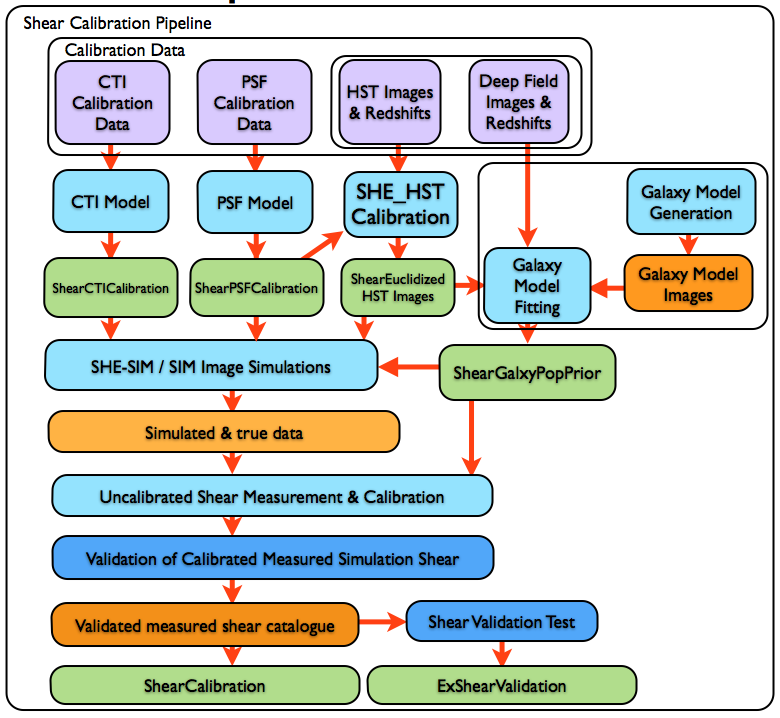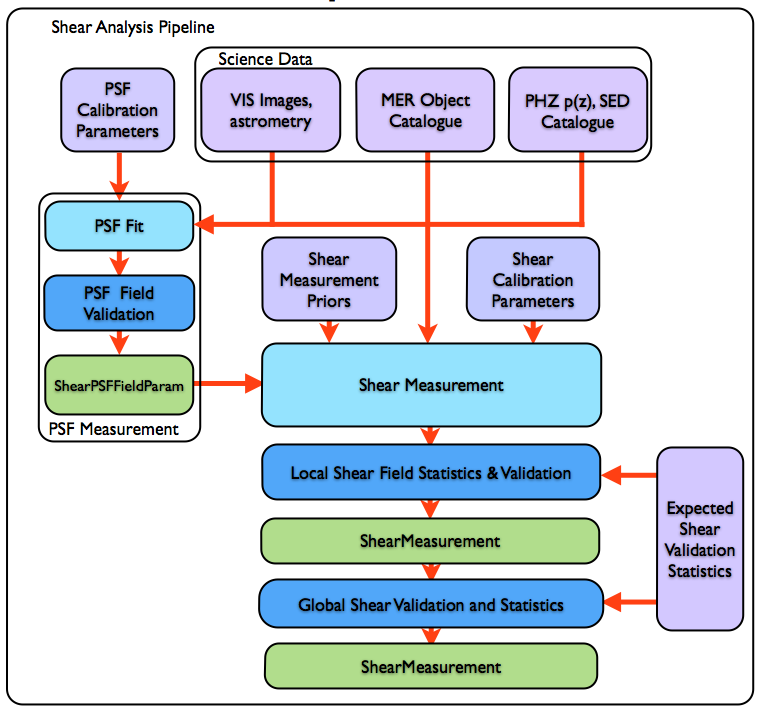Introduction¶
The purpose of the OU-SHE Processing Function (PF) is to take reduced VIS images, along with supplementary data and processed data from OUs MER, PHZ, SIM, EXT, SPE, and use them to generate calibrated, science-ready cosmological shear measurements for use in OU-LE3, and more generally as a core Euclid science product.
The cosmological shear signal is encoded as a distortion in the images of distant galaxies. This distortion, a tidal stretching, is of the order of one percent and must be measured to one part in a thousand by Euclid in order to reach the Requirements on Euclid Primary Science [AD3]. The shear distortion on an individual galaxy image is indistinguishable from the intrinsic galaxy shape and so galaxy images must be combined to estimate the shear. The distortion effects of a Euclid image are captured by the Euclid optical Point Spread Function (PSF). One of the main Processing Elements (PE) of SHE is an accurate model of the Euclid optical PSF which is used to correct the shear measurement.
Shear measurement algorithms can be split into model-fitting methods, which fit a sheared model to each galaxy image, and moment-measuring methods which compress the galaxy image into an effective ellipticity which is then used to estimate shear. Both methods can be formulated in both Frequentists and Bayesian frameworks, depending on what is assumed about the measured statistics and their propagation. As the ellipticity response to shear is nonlinear any estimation method will be intrinsically biased and so either an algorithmic correction needs to be implemented, or the method needs to be calibrated by higher-quality data. The calibration data underlying the shear measurement are galaxy images from the Hubble Space Telescope (HST), processed to look like Euclid data, and the Euclid Deep Fields.
The primary SHE Processing Elements are:
- PSF Correction
PSF generation and calibration.
PSF fitting.
- Shear Measurement
Model Fitting.
Moment measuring.
- Shear Calibration and Validation
HST calibration.
Shear Image Simulations for calibration.
To correct the Euclid galaxy images for instrumental distortion, SHE needs to generate an accurate wavelength-, position-, exposure-, flux- and time-dependent optical PSF model. This will be used to correct images for distortions that contaminate the shear measurement. To carry this out, SHE has developed a detailed PSF analysis based upon a wavefront model of the distortions of the Euclid focal system.
In principle, any shear estimation method can be calibrated to meet Euclid Requirements, provided that it sufficiently captures and adequately encodes the shear information contained in the data for each galaxy. However, in practise not all methods can be calibrated with available calibration data. As different methods have different sensitivities to shear, the calibration data requirements will differ and in some cases may exceed what can reasonably be provided. In addition, as different methods will have different sensitivities to input parameters, they again can require too high an accuracy on measurement parameters. Hence, OU-SHE needs to know the calibrateability of a shear estimation method.
Calibration of the shear measurement is a critical part of the OU-SHE PF. While some aspects of shear estimation bias can be corrected during the measurement process, so-called self-calibration methods, many effects have no simple correction, such as the effects of blended images or selection biases introduced during earlier stages of the shear pipeline. To account for these and to ensure the shear measurement is unbiased, OU-SHE has a calibration stage. In this calibration process realistic simulations and emulations of the Euclid data are generated, based on HST and Euclid Deep Field data, and including the effects of the earlier stages of the pipeline, with a known shear applied per galaxy. The shear is measured without any prior external calibration (but with self-calibration), and the calibration parameter estimated by comparing the uncalibrated shear measurement with the true shear applied to the galaxy images. If the calibration is within Requirements compared to real values, no calibration is applied, but if there is a residual bias, the calibration is applied.
An initial step is the calibration of the shear measurement method, based on HST and Euclid Deep Field data. This is run at every update of the input calibration data. Below is a schematic diagram of data flow in the OU-SHE Weak Lensing Shear Processing Function for calibrating the PSF model, calibrating the cosmic shear signal per galaxy, and generating the validation testing statistics. Purple indicates input data, light blue are the SHE Processing Elements, dark blue indicates validation tests, while green indicates output data to be in the Euclid Archive and orange is intermediate data which is not stored. The shear calibration pipeline which will be run at the start of every update in Operations.

Following calibration the Shear Data Analysis pipeline is run on the Euclid data.
OU-SHE inputs the data from other OUs. In particular, stellar images selected by MER in its star-galaxy separation are ingested into SHE and used to measure the SHE PSF. Cuts are made to the stellar catalogue to optimise the PSF measurement or as part of the validation procedure. Galaxy images are ingested into the shear measurement process, which makes use of the SHE PSF to correct optical distortions.
The shear and PSF catalogues generated by SHE are used to carry out the SHE validation [RD17]. Initially each Euclid field is checked and validated to ensure the local data quality is acceptable. If the field passes this local validation, the catalogue statistics of each field are collected in a master catalogue to be used to characterise the WL quality of the survey. Successful fields will be placed in the EMA and will be used by SHE to make global tests of the WL survey, which will pass or fail.
Fields which fail the validation will be flagged, and if the validation identifies a specific problem, this information will be sent to the relevant OU. This process should be as automated as possible. Below is a schematic diagram of data flow in the OU-SHE Weak Lensing Shear Processing Function for generating the PSF model, measuring cosmic shear signal per galaxy, and the validation testing procedure. Purple indicates input data, light blue are the SHE Processing Elements, dark blue indicates validation tests, while green indicates output data to be in the Euclid Archive and orange is intermediate data which is not stored. The shear measurement analysis pipeline will run on Euclid data.
